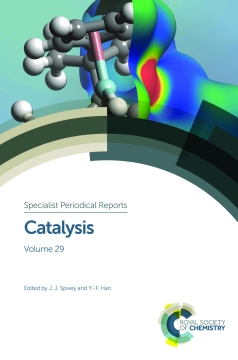
Additional Information
Book Details
Abstract
Catalysts are required for a variety of applications and industrialists and academics are increasingly challenged to find cost effective and environmentally benign catalysts to use. This volume looks at modern approaches to catalysis and reviews the extensive literature on areas such as electrochemical promotion of catalysis, biodiesel-based metals on emission control devices, deoxygenation of fatty acids and transitioning rationally designed catalytic materials to real world catalysts produced on a commercial scale.
Table of Contents
| Section Title | Page | Action | Price |
|---|---|---|---|
| Cover | Cover | ||
| Contents | xxi | ||
| Preface | vii | ||
| Author biographies | x | ||
| Advances in methanation catalysis | 1 | ||
| 1 Introduction | 1 | ||
| 2 Catalyst | 3 | ||
| 3 Reaction mechanism | 10 | ||
| 4 Deactivation mechanism | 15 | ||
| 5 Reactor | 19 | ||
| 6 Conclusion and outlook | 21 | ||
| Acknowledgments | 23 | ||
| References | 23 | ||
| Recent advances in electrochemical promotion of catalysis | 29 | ||
| 1 Introduction | 29 | ||
| 2 Recent advances in the EPOC understanding | 32 | ||
| 3 The route towards of the application | 36 | ||
| 4 Self-sustained electrochemical promotion | 44 | ||
| 5 New trends in EPOC | 51 | ||
| 6 Conclusions | 55 | ||
| References | 56 | ||
| 1 Introduction | 60 | ||
| 2 Families of mixed metal oxides (MOx) | 62 | ||
| 3 Synthesis of metal oxides | 71 | ||
| 4 Mechanistic concepts and relations between material properties and reactivity | 80 | ||
| 5 Conclusion | 86 | ||
| Acknowledgments | 86 | ||
| References | 86 | ||
| Heterogeneous electrocatalysts for CO2 reduction | 94 | ||
| 1 Introduction | 94 | ||
| 2 Low-temperature electrochemical reduction of CO2 | 95 | ||
| 3 High-temperature electrochemical reduction of CO2 | 105 | ||
| 4 Summary and perspectives | 114 | ||
| Acknowledgments | 116 | ||
| References | 116 | ||
| Production and use of H2O2 for atom-efficient functionalization of hydrocarbons and small molecules | 122 | ||
| 1 Overview of H2O2 production and use | 122 | ||
| 2 Processes for the production of H2O2 | 128 | ||
| 3 Direct synthesis of H2O2 | 134 | ||
| 4 General oxidation reactions for commodity chemicals | 160 | ||
| 5 Olefin epoxidation catalysts | 170 | ||
| 6 Oxidation schemes that use H2O2 formed in situ | 192 | ||
| 7 Conclusions | 197 | ||
| Acknowledgments | 199 | ||
| References | 199 | ||
| Transitioning rationally designed catalytic materials to real ‘‘working’’ catalysts produced at commercial scale: nanoparticle materials | 213 | ||
| 1 Introduction | 213 | ||
| 2 Rational catalyst design | 223 | ||
| 3 Catalyst synthesis techniques | 232 | ||
| 4 Transitioning from bench scale to pilot and commercial scale: considerations for validation and scale-up | 245 | ||
| 5 Catalyst cost considerations | 265 | ||
| 6 Conclusions and focus areas for future research | 273 | ||
| Acknowledgments | 275 | ||
| References | 275 | ||
| Dehydrogenation of long chain n-paraffins to olefins – a perspective | 282 | ||
| 1 Introduction | 282 | ||
| 2 Commercial production long chain n-paraffins | 283 | ||
| 3 Long chain n-paraffins dehydrogenation – commercial PacolTM process | 285 | ||
| 4 Evaluation of the long chain n-paraffins dehydrogenation catalyst and process | 288 | ||
| 5 Mechanism of long chain n-paraffins dehydrogenation | 293 | ||
| 6 Thermodynamics of long chain n-paraffins dehydrogenation | 296 | ||
| 7 Kinetics of long chain n-paraffins dehydrogenation | 298 | ||
| 8 Catalyst for long chain n-paraffins dehydrogenation | 301 | ||
| 9 Catalyst deactivation and regeneration | 306 | ||
| 10 Emerging technologies for long chain n-paraffins dehydrogenation | 310 | ||
| 11 Conclusions | 312 | ||
| Acknowledgments | 313 | ||
| References | 313 | ||
| Investigations of the impact of biodiesel metal contaminants on emissions control devices | 317 | ||
| 1 Introduction | 317 | ||
| 2 Methods for evaluating metal impacts | 319 | ||
| 3 Results and discussion | 323 | ||
| 4 Conclusion | 339 | ||
| References | 339 |
